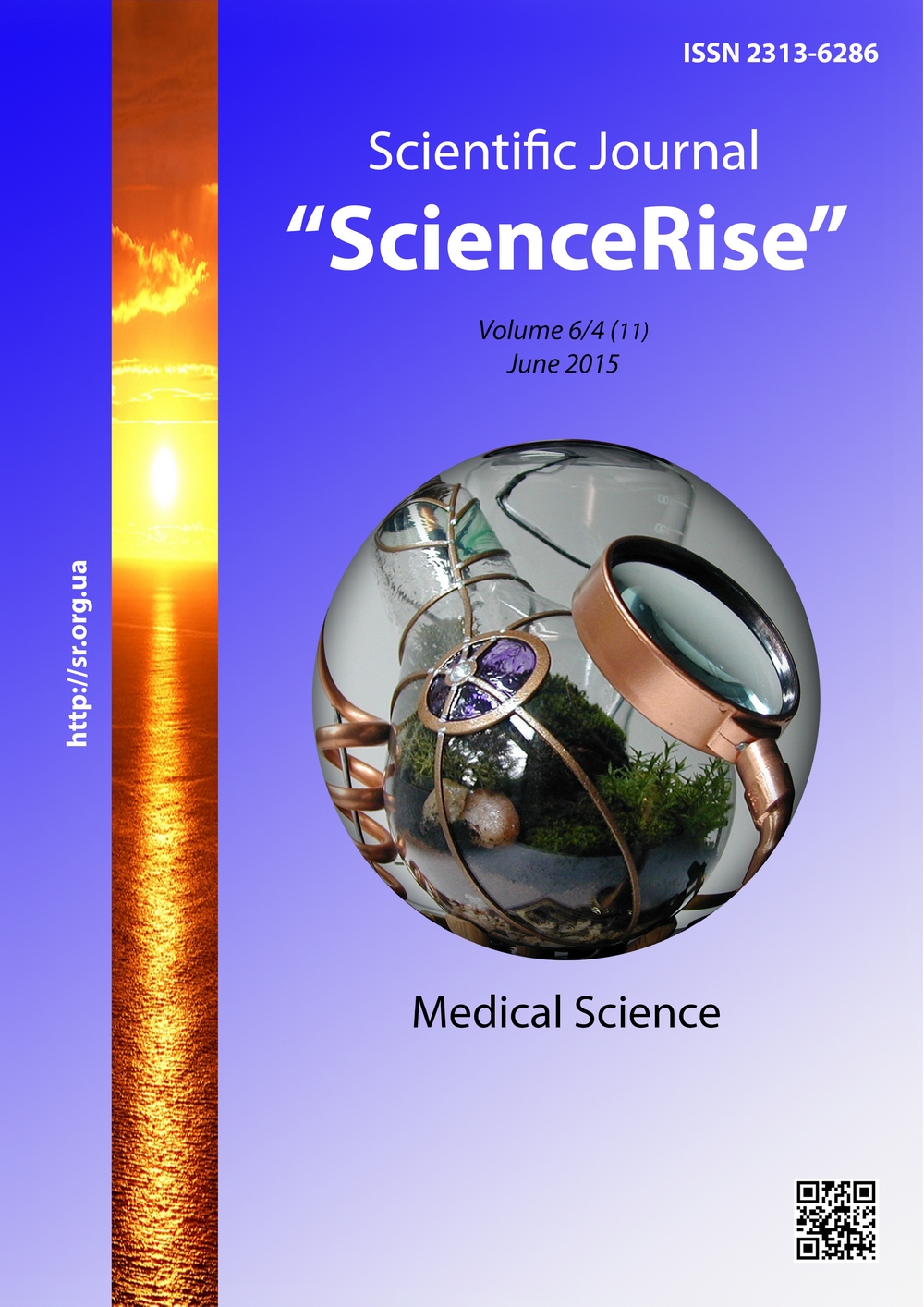Assessment of splenic blood flow in patients with the compensated and decompensated course of cirrhosis
DOI:
https://doi.org/10.15587/2313-8416.2015.45162Keywords:
cirrhosis, splenomegaly, splenic blood flow, ultrasound scanning, dopplerographyAbstract
Splenomegaly, increased splenic blood flow are the specific characteristics of the natural course of cirrhosis. But an importance of these alienations is inadequately appreciated when choosing methods of correction the portal hypertensia syndrome.
Aim of the study. To assess the splenic blood flow in patients with compensated and decompensated course of cirrhosis.
Materials and methods.190 patients with cirrhosis were under surveillance: 123 had the gastrointestinal bleeding, 67 – the refractory ascites. 84 patients died during surveillance. The surveillance lasted from 2-3 weeks to 2,5 -3 years.
All patients underwent reiterated ultrasound study of an abdominal cavity. The dimensions of spleen, diameter of hepatic and splenic vessels were assessed; the qualitative and quantitative characteristics of blood flow in hepatic and splenic arteries, portal and splenic veins were defined.
Result of the study. All cirrhosis patients have the different degree of splenomegaly with increase of volumetric blood flow in splenic artery and vein in 1,3 and 3,2 times respectively. At the decompensation of disease on the background of decrease of the blood flow in portal vein, hepatic and splenic arteries, the blood flow in splenic vein practically didn’t change. The ratio between the volumetric blood flow in splenic vein and the portal one at decompensation of disease increased from 65,5±18,0 % to 99,1±27,0 %, while the norm is 43,2±15,0 % (р < 0,01), that can be the one of prognostic indications of the complications development.
Conclusions. The natural course of cirrhosis characterizes by increase of the splenic blood flow relative to the portal one when transition from the compensated state to the decompensated one, that can be one of the factors of increase of the portal pressure and hemodynamic causes of the complications development that must be taken into account choosing method of correction the syndrome of portal hypertensia
References
Gracia-Sancho, J., Maeso-Díaz, R., Fernández-Iglesias, A., Navarro-Zornoza, M., Bosch, J. (2015). New cellular and molecular targets for the treatment of portal hypertension. Hepatology International, 9 (2), 183–191. doi: 10.1007/s12072-015-9613-5
Koh, C., Heller, T. (2012). Approach to the diagnosis of portal hypertension. Clinical Liver Disease, 1 (5), 133–135. doi: 10.1002/cld.78
Tripathi, D. (2012). Drugs used in therapy of portal hypertension. Clinical Liver Disease, 1 (5), 136–138. doi: 10.1002/cld.97
Iwakiri, Y., Shah, V., Rockey, D. C. (2014). Vascular pathobiology in chronic liver disease and cirrhosis – Current status and future directions. Journal of Hepatology, 61 (4), 912–924. doi: 10.1016/j.jhep.2014.05.047
Moller, S. (2014). Extrahepatic complications to cirrhosis and portal hypertension: Haemodynamic and homeostatic aspects. World Journal of Gastroenterology, 20 (42), 15499–15517. doi: 10.3748/wjg.v20.i42.15499
Prin, M. (2015). Hepatosplanchnic circulation in cirrhosis and sepsis. World Journal of Gastroenterology, 21 (9), 2582–2592. doi: 10.3748/wjg.v21.i9.2582
Schwabl, P., Payer, B. A., Grahovac, J., Klein, S., Horvatits, T., Mitterhauser, M. et. al. (2014). Pioglitazone decreases portosystemic shunting by modulating inflammation and angiogenesis in cirrhotic and non-cirrhotic portal hypertensive rats. Journal of Hepatology, 60 (6), 1135–1142. doi: 10.1016/j.jhep.2014.01.025
Yang, Y.-Y., Liu, R.-S., Lee, P.-C., Yeh, Y.-C., Huang, Y.-T., Lee, W.-P. et. al. (2013). Anti-VEGFR agents ameliorate hepatic venous dysregulation/microcirculatory dysfunction, splanchnic venous pooling and ascites of NASH-cirrhotic rat. Liver International, 34(4), 521–534. doi: 10.1111/liv.12299
Abragamovich O. O., Dovgan', Ju. P., Ferko, M. R., Abragamovich, M. O., Tolopko, S. Ja. (2013). Ul'trazvukova dopplerofloumetrichna dіagnostika sindromu portal'noї gіpertenzії u hvorih na ciroz pechіnki ta znachennja її pokaznikіv dlja prognozu. Suchasna gastroenterologіja, 3 (71), 45–50.
Garbuzenko, D. V. (2012). Metody prognozirovanija riska i monitoring jeffektivnosti terapii krovotechenij iz varikozno-rasshirennyh ven pishhevoda u bol'nyh cirrozom pecheni. RZhGGK., 2, 36–44.
Medvedev, V. E., Kalimon, O. R. (2006). Ul'trvzvukova dopplerografіja pri cirozі pechіnki. Promeneva dіagnostika, promenenva terapіja, 2, 22–30.
Shipov, O. Ju. (2002). Diagnostika portal'noj giperetenzii pri ul'trazvukovoj angiografii pecheni. Moscow, 18.
Abd Elrazek, A. E. M. A., Mahfouz, H. M., Metwally, A. M., El-Shamy, A. M. (2014). Mortality prediction of nonalcoholic patients presenting with upper gastrointestinal bleeding using data mining. European Journal of Gastroenterology & Hepatology, 26 (2), 187–191. doi: 10.1097/meg.0b013e328365c3b0
Kim, M. Y. (2014). Invasive and non-invasive diagnosis of cirrhosis and portal hypertension. World Journal of Gastroenterology, 20 (15), 4300–4315. doi: 10.3748/wjg.v20.i15.4300
Baik, S. K. (2010). Haemodynamic evaluation by Doppler ultrasonography in patients with portal hypertension: a review. Liver International, 30 (10), 1403–1413. doi: 10.1111/j.1478-3231.2010.02326.x
Colecchia, A., Colli, A., Casazza, G., Mandolesi, D., Schiumerini, R., Reggiani, L. B. et. al. (2014). Spleen stiffness measurement can predict clinical complications in compensated HCV-related cirrhosis: A prospective study. Journal of Hepatology, 60 (6), 1158–1164. doi: 10.1016/j.jhep.2014.02.024
Tashiro, H., Ide, K., Amano, H., Kobayashi, T., Onoe, T., Ishiyama, K. et. al. (2012). Surgical treatment for portosystemic encephalopathy in patients with liver cirrhosis: Occlusion of portosystemic shunt in combination with splenectomy. Hepatology Research, 43 (3), 249–254. doi: 10.1111/j.1872-034x.2012.01059.x
Downloads
Published
Issue
Section
License
Copyright (c) 2015 Алий Саитович Тугушев, Виталий Викторович Вакуленко, Ольга Степановна Черковская, Дмитрий Иванович Михантьев, Вячеслав Васильевич Нешта, Павел Иванович Потапенко

This work is licensed under a Creative Commons Attribution 4.0 International License.
Our journal abides by the Creative Commons CC BY copyright rights and permissions for open access journals.
Authors, who are published in this journal, agree to the following conditions:
1. The authors reserve the right to authorship of the work and pass the first publication right of this work to the journal under the terms of a Creative Commons CC BY, which allows others to freely distribute the published research with the obligatory reference to the authors of the original work and the first publication of the work in this journal.
2. The authors have the right to conclude separate supplement agreements that relate to non-exclusive work distribution in the form in which it has been published by the journal (for example, to upload the work to the online storage of the journal or publish it as part of a monograph), provided that the reference to the first publication of the work in this journal is included.

